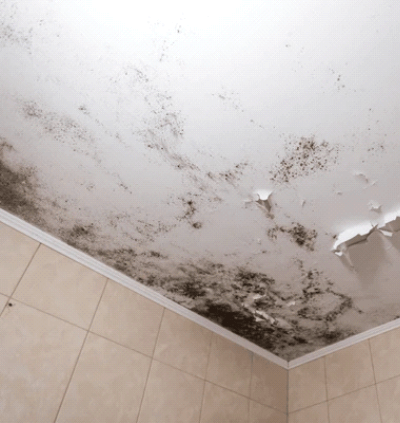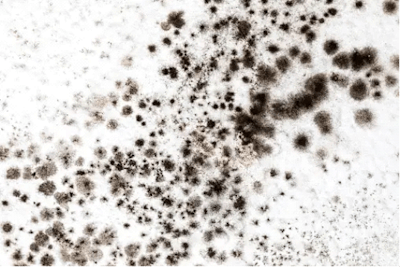While mold can grow anywhere in your house, your bathroom and kitchen are at a greater risk. Due to high humidity and rising temperatures, kitchens can easily grow and foster mold and mildew.
Since cabinets remain closed and are not ventilated, trapped air in them increases the risk of mold formation on your wood cabinets. However, there are a few things you can do to either kill or prevent mold in the kitchen cabinets.
Additionally, food stored within kitchen cabinets is often the source of the mold that grows on them. In general, mold can grow easily and rapidly in closed kitchen cabinets due to their high levels of humidity.
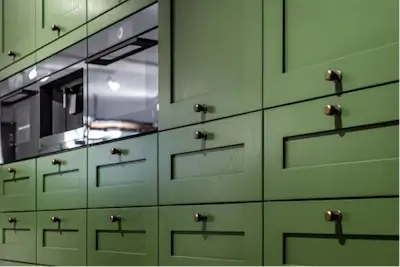
Signs of Mold in Kitchen Cabinets
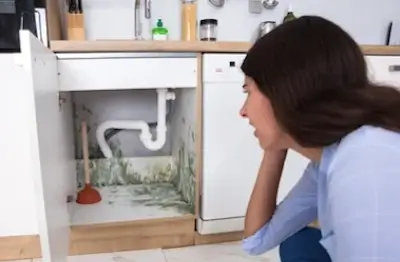
Look for the following signs in order to identify any mold related problems in your kitchen:
1. A Stale Odor
Excess moisture under the sink, behind the refrigerator, in the corners of cupboards and pantries, or other dark spaces provides an optimum environment for mold growth. The first indication that you might have mold in any of these areas is frequently a musty, earthy smell. Mold has a strong smell that’s hard to miss and difficult to get rid of.
2. Water Seepage
Any water leaks in your kitchen, no matter how tiny, can cause mold development that goes undetected. If your sink is leaking, if the pipes are clogged, or if the tile grout is missing or broken, look for mold in the cabinets. Water retention due to leaks causes high humidity and leads to mildew and mold.
3. Warping or Discoloration
Any yellowing or warping of the walls, flooring, or ceilings is another obvious symptom that you have mold in your kitchen. Over time, moisture may leak into the cabinets and cause water damage along with fungal growth. Pay attention to these signs and remedy the issue.
4. Damaged Wallpaper or Paint
High levels of humidity create an ideal climate for the growth of mold, which is why your kitchen’s paint or wallpaper may peel or bubble. Trapped moisture causes the deterioration of paints especially inside the closed cabinets. Any signs that indicate moisture or water damage are a sign of mold in the kitchen, especially the cabinets.
5. Excess Condensation
Excessive condensation on the walls, pipes, or windows in your kitchen could be a sign of high humidity. These signs also indicate that there’s mold growing in hidden spots such as inside the cabinets. You need to ventilate the kitchen cabinets to remove trapped moisture.
6. Allergic Reactions
Mold can cause allergies and other health issues. Notice if you are having more than usual symptoms of mold allergy. These include sneezing, irritated throat, shortness of breath, itchy or watery eyes, runny nose, and shortness of breath. Open your cabinets and check if there’s any mold hiding there, making you sick.
What Causes Mold in Kitchen Cabinets?
The following are the most common causes of mold growth in kitchen cabinets:
Moisture Buildup
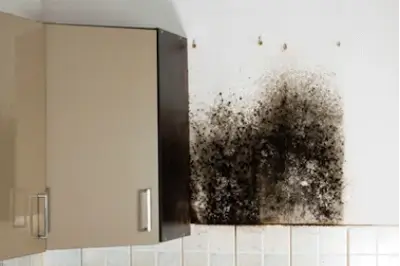
Humidity, which might manifest as moisture in the air, is one of the primary causes.
This might be a major issue if you are cooking without turning on your exhaust fan or opening the windows. Mold can grow in areas where there is a lot of moisture in the air and humidity.
This moisture creeps inside the cabinets and starts eating the wood.
Water Leaks
Mold can develop from other types of moisture as well. For example, even a small leak from pipes might result in mold growth. Because of the dampness, cabinets close to drainage and sinks are frequently affected by mold growth.
Food and Other Organic Material
Mold loves organic material. Kitchen cabinets made from wood become an easy victim. Other causes of mold in kitchen cabinets include improper cleaning, leaving expired food out, and more. Dishes and plates that have not been thoroughly dried before being stored may contain moisture that allows mold to grow.
Mold can grow on these and then spread to your cabinets if food is kept in the cabinets for an extended time.
How to Prevent Mold in Kitchen Cabinets
Proper ventilation is the key to preventing fungus growth. There are a few more steps to reduce moisture and prevent mold in kitchen cabinets.
Frequent Cleaning
Regular cleaning is your next best ally when it comes to preventing mold growth, after ventilation. You can use a dehumidifier to reduce moisture and an air purifier to trap mold spores.
Proper Ventilation
Proper and frequent ventilation is the most important step in preventing mold. You may avoid the accumulation of too much moisture in your kitchen by making sure there is adequate air circulation there.
Fast Repairs
Wet walls and leaking plumbing can serve as a breeding ground for mold. Make sure that any leaks or water damage are fixed right away to prevent the growth of mold in your kitchen.
Steps for Cleaning Mold in Kitchen Cabinets
As you already know, humidity, warmth, and a lack of ventilation facilitate mold growth. Mold can grow within kitchen cabinets when moisture seeps in and stays there for as little as 24 hours. Contact a mold removal company as cleaning mold is tricky and hazardous to health. However, little mold in kitchen cabinets can be removed using household products or store-bought mold-killing sprays.
When cleaning mold, the first step is to always wear protective gloves, masks, goggles, and disposable coveralls.
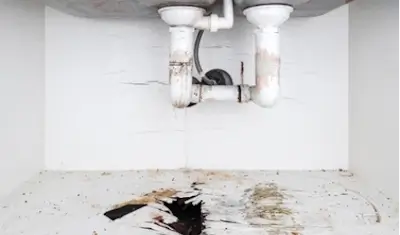
Choose a Cleaning Agent
You can use a store-bought mold-killing agent to get rid of fungus in the cabinets. If you’re a DIY person, mold can also be removed with common household items like hydrogen peroxide, distilled white vinegar, and bleach. Avoid combining these several cleaners in one go.
Vinegar and baking soda paste are good for such spots. If your cabinets are not at risk of color fading, you can use hydrogen peroxide, borax, and bleach as well.
Apply the Solution
If you’re using a commercial product, follow the manufacturer’s instructions when spraying your cleaning solution onto the mold. Alternatively, you might use a scrub brush with firm bristles or a towel to remove the mold. To reach places that are difficult to reach, use an old toothbrush.
Scrub the Affected Area
Let the cleaning solution dry out completely. Once it’s dry, scrub off any remaining mold from the cabinet with warm water and a clean towel.
Dry out the Cleaned Area
After completely drying the cabinet, look for signs of mold growth. If the mold is still present, go through the cleaning procedures once more, making sure to thoroughly dry everything afterward.
Conclusion
If you’ve spotted mold in your kitchen cabinets, don’t wait for it to spread. Contact 24/7 Service Pros for mold removal and prevention services. Mold in cabinets can pose health risks and compromise the integrity of your home.
Which Areas We Serve in South Florida?
- Hollywood
- Davie
- Miami Beach
- Weston
- Hallandale Beach
- North Miami Beach
- Sunrise
- Tamarac
- Coconut Creek
- Fort Lauderdale
- Miami
- Boca Raton
- Hialeah
- Margate
- Pembrock Pines
- Dania Beach
- Lauderhill
- Delray Beach
- Pompano Beach
- Deerfield Beach
- Coral Springs
- Plantation
- Doral
- Aventura
- Miramar
- Sunny Isles Beach

